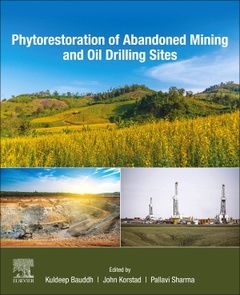Description
Phytorestoration of Abandoned Mining and Oil Drilling Sites
Coordinators: Bauddh Kuldeep, Korstad John, Sharma Pallavi
Language: English
Subjects for Phytorestoration of Abandoned Mining and Oil Drilling Sites:
Keywords
Acid mine drainage; Algae; Antioxidants; Arid environment; Bioaccumulation; Biodiversity development; Biodiversity loss; Bio-economy; Bioenergy crop; Bioenergy crops; Biomass; Carbon sequestration; Castor oil; Castor plant; Chelators; Chromium; Coal combustion product (CCP); Coalmine degraded lands; Constructed wetland; Defense; Degraded lands; Ecological restoration; Ecology; Eco-rejuvenation technology; Ecorestoration; Environmental impacts; Environmental pollution; Essential oil; Ex-mining catchment; Forest regeneration; Gold mining; Grass-legume; Heavy metal; Heavy metal leaching; Heavy metals; Human health; Hydrocarbons; Hyperaccumulators; Industrialization; Invasive species; Iron; Laws and regulations; Lemongrass; Lianas; Life cycle analysis; Macrophytes; Mechanisms; Metalliferous mine waste; Metals; Mine filling; Mine tailing; Mine tailings; Mining; Mining sites; Multilayer canopy; Native flora; Oil drilling sites; Oil spill; Ornamental plants; Petroleum contaminants; Phycoremediation; Phytoavailability; Phytodegradation; Phytoextraction; Phytomanagement; Phytomining; Phytoremediation; Phytosequestration; Phytostabilization; Plant species; Plants; Pollution; Purun tikus; Radioactive; Remediation; Remediation method; Restoration; Restore; Semiarid environment; Shale gas development; Soil amendments; Soil contamination; Tree; Uranium tailings
538 p. · 19x23.3 cm · Paperback
Description
/li>Contents
/li>Readership
/li>Biography
/li>Comment
/li>
Phytorestoration of Abandoned Mining and Oil Drilling Sites presents case studies and the latest research on the most effective methods to address the large amounts of waste materials released due to mining and oil drilling. In particular, phytoremediation is described as a novel, eco-friendly, cost-effective method for extracting toxic compounds by plants for the restoration of contaminated sites. Plantings on these contaminated areas lead to the removal of toxic substances such as heavy metals and hydrocarbons, improvement in the physicochemical and biological properties of the soil, long-term forest ecosystem rehabilitation, restoration of ecosystem productivity, stability and biological diversity, and reductions in CO2.
Utilizing worldwide examples, this book discusses the potential of phytoremediation as an ideal solution for sites contaminated by mining and oil drilling sites.
2. An Overview of Phytorestoration of Former Mining and Oil Drilling Sites
3. Contamination of the Stream Water and Sediments with Uranium Mine and Their Possible Phytoremediation
4. Influence of Open Cast Mining on the Soil Properties of Ledo Colliery of Tinsukia District of Assam, India
5. Potential of Purun tikus to Restore the Iron (Fe) Contaminated Acid Mine Drainage by Using Constructed Wetland
6. Phytoreclamation of Abandoned Acid Mine Drainage Site after Treatment with Fly Ash
7. Role of Fungi in Restoration of Mine Dump Soil Contaminated with Petroleum Hydrocarbons
8. Assessment of Native Plant Species Growing in Mining-Spoiled Soils for Phytorestoration of Heavy Metals
9. Assessment of Phytoremediation Potential of Plant Species in Copper Mine Tailings
10. Phytostabilization of Metalliferous Mine Waste
11. Restoration of Coal Mine Waste Sites by Using Plant Species
12. Phytoaccumulation of Trace Elements by Grevillea pteridifolia Knight Grown on Iron Ore Tailings
13. Evaluation of Natural Phytoremediation Processes Occurring at Ex-Tin Mining Catchment
14. Uranium Mine Tailing Remediation by Amending Land Soil and Invading Native Plant Species
15. Physiological and Antioxidant Responses in Plants Exposed to Heavy Metals During Cultivation in Mining Dump Sites
16. Potential of Ricinus communis for the Removal of Toxic Metals from Mining Dumping Sites
17. Phytorestoration Potential of Invasive Plant Species during Cultivation in Mining Dump Sites
18. Phytoextraction of Heavy Metals by Tree Species Growing on Hazardous Mining Sludge
19. Selection of Plant Species for Phytoremediation of Oil Drilling Sites: An Overview
20. Phytoremediation Study of Oil Spill Site Using Common Nigerian Vegetables
21. Case Studies of Phytorestoration of Abandoned Oil Drilling Sites
22. Phytoremediation of Oil Contaminated Aquatic Sites using Aquatic Macrophytes
23. Phytomining: A Sustainable Approach for Recovery and Extraction of Valuable Metals
24. Phytomining Potential of Albizia julibrissin Plant
25. Restoring Indigenous Knowledge for Mining Dump Sites: A Study at Iron Mining Areas in Jharkhand
Dr. John Korstad is a Professor of Biology and Past Director of the Honors Program at Oral Roberts University in Tulsa, Oklahoma (USA). His educational background includes a BA in Geology and BS in Biology from Calif. Lutheran University, a MS in Environmental Science from Cal. State Hayward, and a MS and Ph.D. in Zoology from the Univ. Michigan. His specialty is Limnology (lake ecology) with specific expertise in nutrient-phytoplankton (microalgae)-zooplankton interactions and lake management. He has vast experience in aquaculture, including two sabbatical years doing research at The Foundation for Scientific and Industrial Research (SINTEF) in Trondheim, Norway (the second one funded by a Fulbright Fellowship).
Dr. Pallavi Sharma is Professor at the School of Environment and Sustainable Development, Central University of Gujarat, India. Dr. Sharma is currently engaged in work on the mechanisms of abiotic stress tolerance in plants. She has published 50 scientific articles/book chapters in peer-reviewed journals/books with more than 7,600 citations.
- Includes exploration of efficient plants for restoring contaminated former mining and oil drilling sites
- Addresses adverse impacts of toxicants released from mining activities on living organisms, including human health
- Presents characteristics of contaminated former mining and oil drilling sites
These books may interest you

Phytomanagement of Fly Ash 116.98 €



